How to identify a fake Micro SD flash card
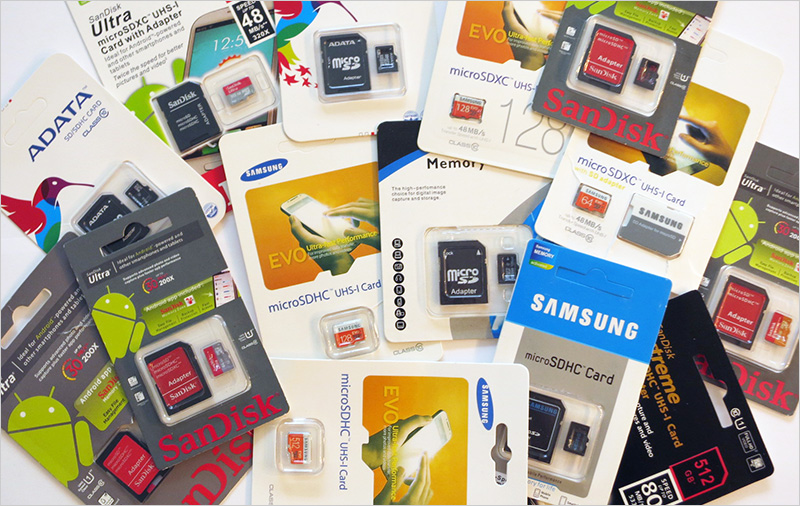
Foreword
Recently, Micro SD cards are becoming more popular. On this occasion, there are more and more sellers who are ready to profit from this deception and various tricks on this subject.
Somehow I needed a Micro SD card with a capacity of 64GB for a small project on the Raspberry Pi. But when I started looking for something suitable on eBay, I was surprised to find that the overwhelming majority of sellers expose outright fakes. Even on Amazon, the situation was not very attractive in this regard. In the picture above, all cards are fakes.
After that, I decided to order several such fakes and share it here to protect the rest not only from losing money, but also from losing data. But the data is often more expensive.
I promise slides.
What is it?
To begin with, I will decide what exactly I consider to be a fake, since there are different fakes.
Two main types of memory card fakes are:
- Faking a tank
This is the most popular way to meet a fake. In this case, the card works at a much lower capacity than promised. I will consider this case here. - Counterfeiting a brand model
This is much less common and counterfeiting consists in slipping the worst card under the guise of a more expensive one. This happened a long time ago when the price difference in the models was very significant.
Yes, there will be slides soon.
Like this?
First you need to understand how you can fake a tank.
Roughly speaking, flash cards consist of two main components - the controller and the flash chip itself. For the interaction with the host (computer, camera, etc.), a controller is responsible that knows the type of the connected flash microcircuit, speed, the protocol for communicating with the host and other administrative activities in servicing the card as a whole.
If, for example, a flash chip has a capacity of 16GB, the controller will tell the host about it. In this case, the host will know that it is impossible to write more than 16GB and everyone will be happy.
But if the controller is programmed to tell a different capacity (for example, 64GB), then the host will think that it is a 64GB card, although the amount of data that can be stored on this card will also be 16GB.
That is, if you insert the card into a computer or camera, they will show that this card is 64GB, but all data after recording 16GB will be completely lost.
Due to the nature of the organization of flash chips, when the access address is full, the recording will start again from the beginning and overwrite the old data. In these cases, the controller is usually programmed so that the recording does not go in a circle, but simply writes to the void. That is, when reading, zeros or something else monotonous will be returned instead of the recorded data.
There are such fakes where it is not implemented and the card becomes completely inaccessible, as some service information is erased there or other processes of such a plan occur. However, these are more rare cases.
Yes, there will certainly be slides.

Card types
To begin with, a little more theory about SD cards ... Yes, I remember that I promised slides, I have to be patient a bit more.
There are three main SD card standards:
- SD (or SDSC). These are cards with a capacity of up to 4GB
- SDHC. Capacity from 4GB to 32GB inclusive
- SDXC. They have capacities from 64GB to 2TB
This will help us a lot in identifying fakes.
There is also UHS-I, UHS-II, Class 10, Class 6, but this all relates to speed and in this case does not affect anything, since we do not consider it.
How to check?
Since the controller says the wrong capacity, checks like "I looked at how many gigabytes of Windows showed available" will not work. Normal formatting will not help either, as this does not check capacity, but simply initializes the file system.
There are several ways to determine a fake:
- Read-write check .
The most reliable way to identify a fake. For example, if the card was able to write 64GB, and read correctly a little less than 8GB, then this is an obvious fake. - Visual inspection .
Typically, fakes are quite poor quality and therefore they can be identified by many visual signs and inconsistencies.
Now more about each method.
No need to panic, we almost reached the slides.
The method of "write-read"
This method requires a compatible card reader. It is enough to write a few large files and try reading with checking the md5 / sha hash or just some other checksum.
To simplify the process, there are various programs that can automate this. Perhaps the most popular is h2testw.
For example, it looks like the result of testing a 64GB fake, which actually turned out to be an 8GB card:
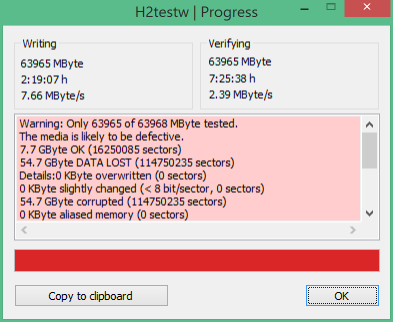
h2testw runs on Windows.
There are other options. For example, the console open source program F3 , which can be assembled under Windows, Linux, Mac.
Or, for example, FakeFlashTest (Windows) , which can scan faster because it tests selectively.
Visual way
Software methods are accurate, but the inconvenience is that you have to pay and get this card. That is, time will be minimally spent, and possibly money.
Fortunately, the fakes are now at such a level that they are fairly easy to identify from photographs of goods from the seller.
I specifically ordered a couple of dozen different cards just to learn more about how they look and how they can be easily identified.
Now slides
All-all-all of the cards below only work on the first 8GB. That is, all cards are a rework of 8GB cards. And in addition, which is very slow (Class 2).
- Noname 128GB Micro SD
Very popular Micro SD card in noname packaging. Always fake . Without options:
Fake criteria:
The package does not have the logo “SDXC”, which relies on cards from 64GB and above.
On the SDHC logo card itself, which is designed for 32GB and lower cards.
Fun moments:
The inscription "100% tested." What exactly was tested is not clear. Apparently, the quality of the fake.
The inscription "Tech support". No contact information for this support is indicated on the package. Beat the rail? - Sandisk Extreme 64GB Micro SD
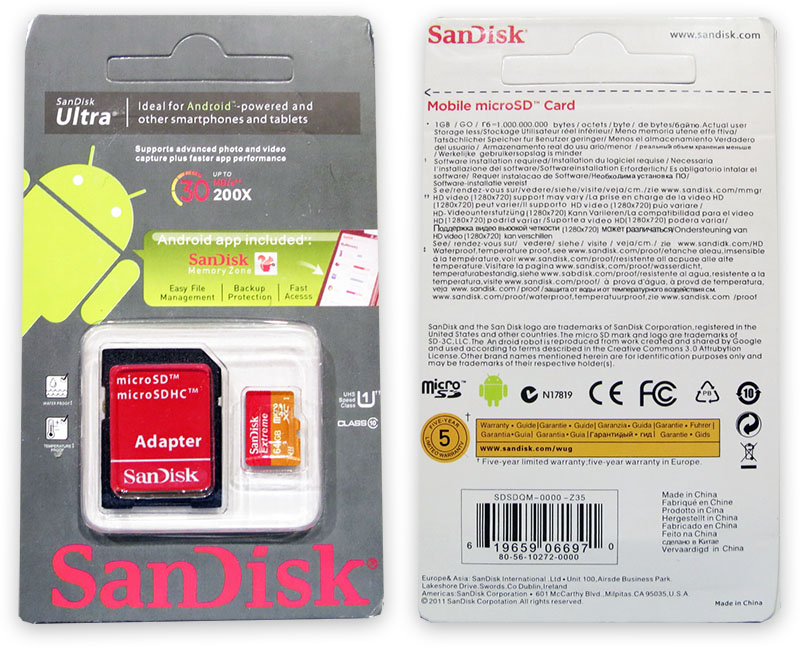
Counterfeit criteria:
Sandisk Ultra packaging, and Sandisk Extreme card itself.
Card capacity is not indicated on the package.
The model SDSDQM-0000-Z35 indicated on the back of the packaging does not exist.
On the packaging is the logo “Micro SD”, not “SDXC”.
UPC barcode 619659066970 corresponds to the old 2GB card.
There are typos on the back of the package. - Sandisk Extreme 128GB Micro SD
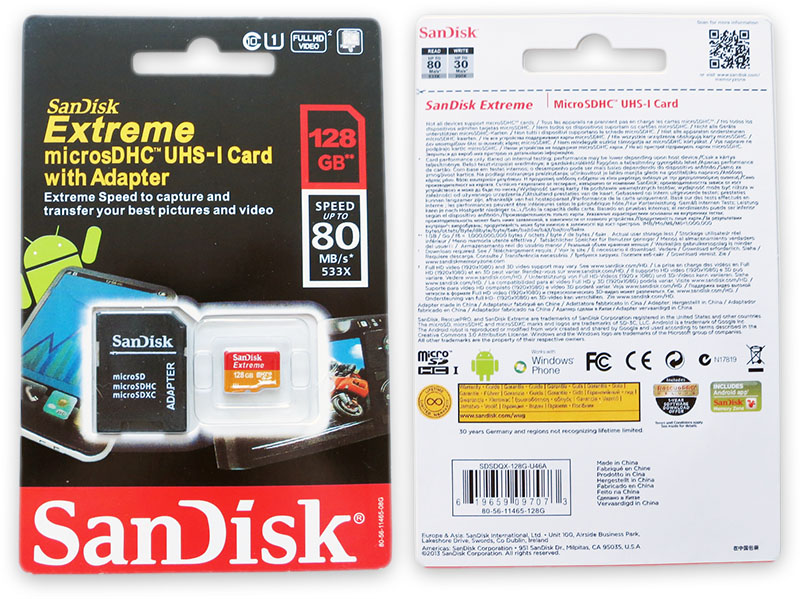
Counterfeit Criteria:
Sandisk has no 128GB Extreme Micro SD card. The largest is 64GB.
The packaging says “SDHC” instead of “SDXC”.
"MicrosDHC" was written with an error in capitalizing the letter "s".
A lot of typos on the packaging on the back.
Invalid model SDSDQX-128G-U46A.
UPC barcode 619659097073 from 16GB card. - Sandisk Ultra 128GB Micro SD
Relatively good fake on Sandisk: Fake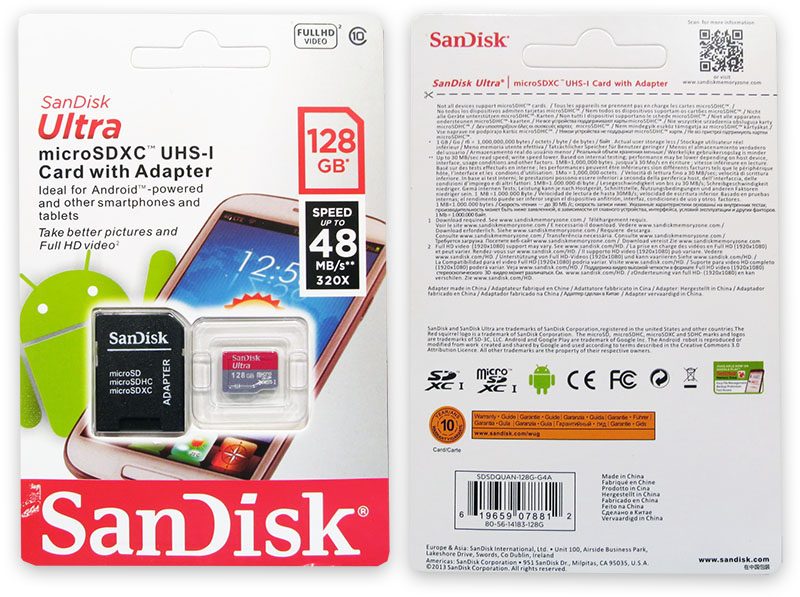
criteria:
The original card of this model and such a capacity is completely black with red letters. And here is red and gray.
The 128GB background is not the one Sandisk uses on its cards. - Sandisk Extreme 512GB Micro SD
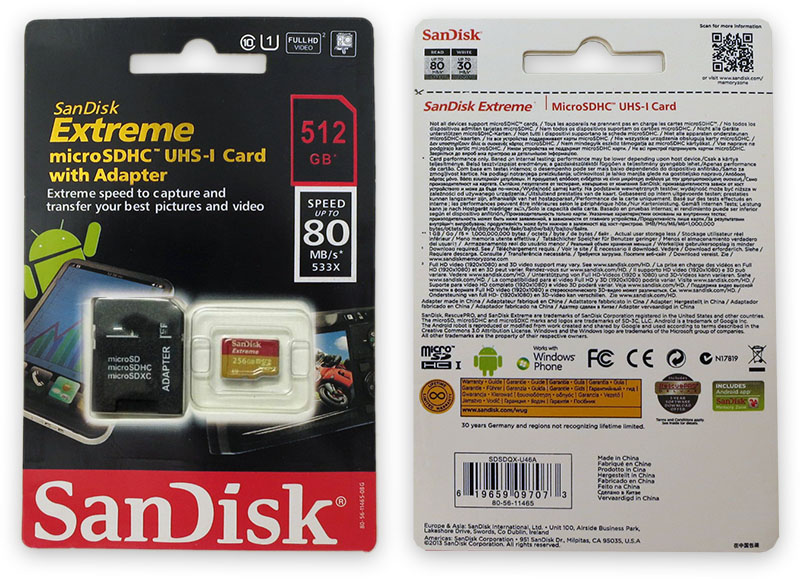
Counterfeit Criteria:
Sandisk does not have 512GB Micro SD cards.
“SDHC” instead of “SDXC”.
Inside lies a 256GB card. This is already the height of arrogance, since I ordered 512GB. However, Extreme Micro SD card on 256GB also does not exist with Sandisk'a.
Invalid model SDSDQX-U46A.
UPC barcode 619659097073 from the card to 16GB. - Sandisk Ultra 512GB Micro SD Fake
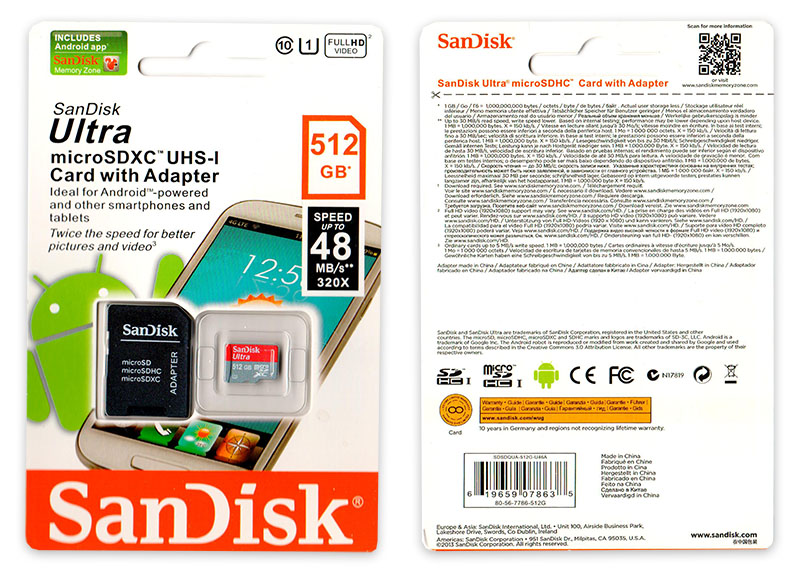
Criteria:
Non-existent capacity, since Sandisk does not have 512GB in this format.
As usual, “SDHC” instead of “SDXC”.
Invalid model SDSDQUA-512G-U46A.
Non-existent UPC barcode 619659078635.
It is not visible in the photo, but the card can be removed simply by opening the plastic cover. And on the original Sandisk, you must definitely cut the packaging. - ADATA 128GB and 64GB Micro SD
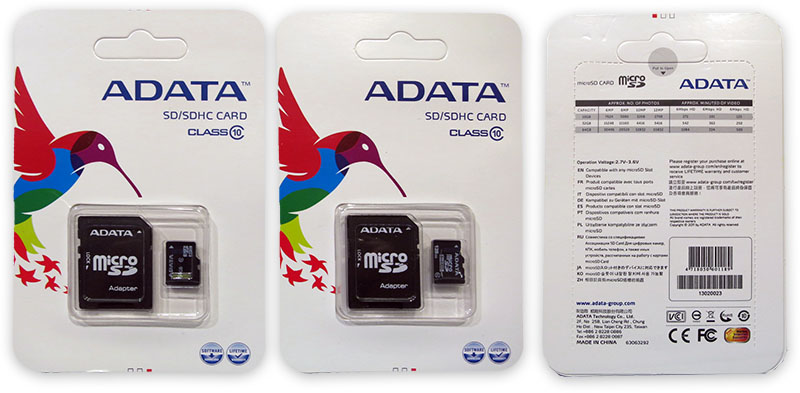
Counterfeit Criteria: Capacity
not indicated on package.
“SDHC” instead of “SDXC”.
The 128GB card (in the middle) has the inscription turned upside down.
On 128GB and 64GB packages, the same UPC barcode is 4718050601189, which belongs to a 2GB card. - Samsung EVO 128GB Micro SD
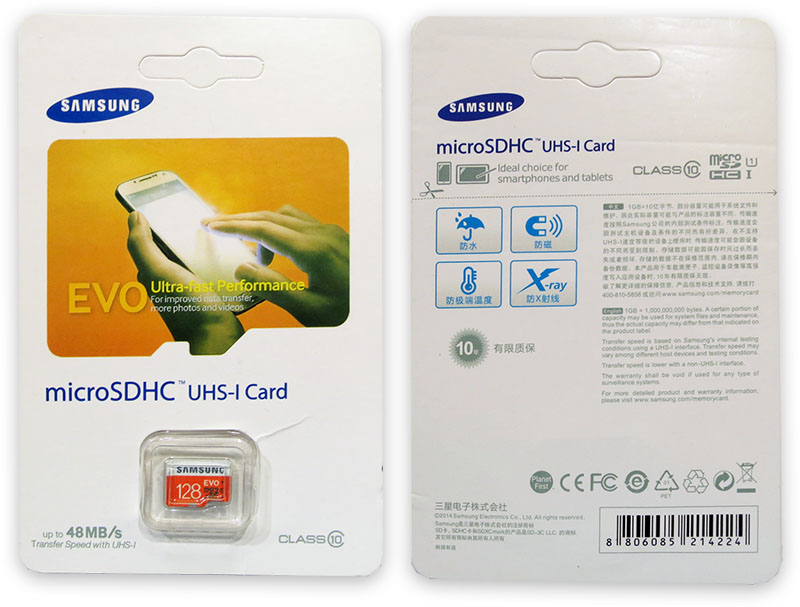
Fake Criteria:
No capacity on the package.
The usual "SDHC" instead of the correct "SDXC".
UPC barcode 8806085214224 from the card to 32GB. - Samsung EVO 64GB Micro SD
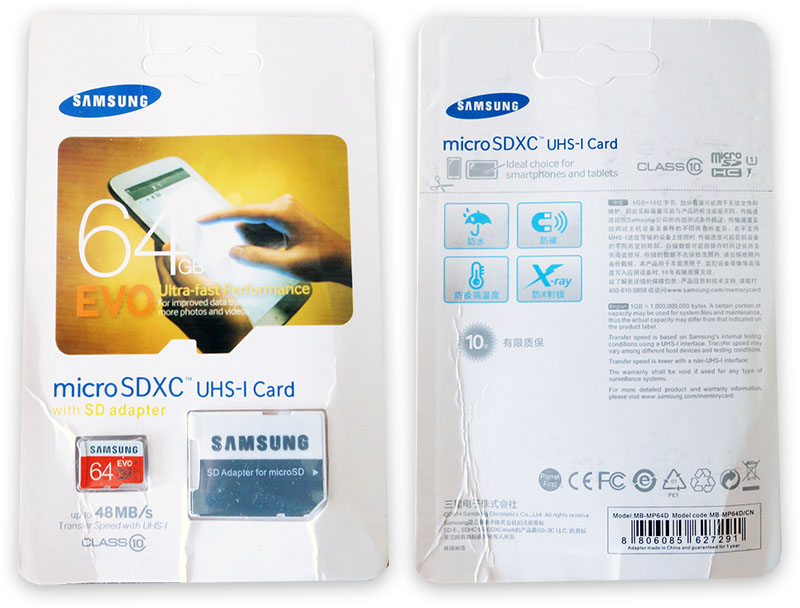
Counterfeit Criteria:
Awful print quality - the text merges in the picture and is difficult to read. As if printed on a low-quality inkjet printer.
Trite "SDHC" instead of "SDXC".
UPC barcode 8806085627291 from another 16GB card.
In general, if you take the Samsung EVO card in your hands, then the original card has a slightly different coloring. For example, the ends of the card are painted in white there, while the counterfeit paint only on top of the surface. Samsung cards can also be made only in Korea or the Philippines. In Taiwan, they are not produced. - Samsung 512GB Micro SD
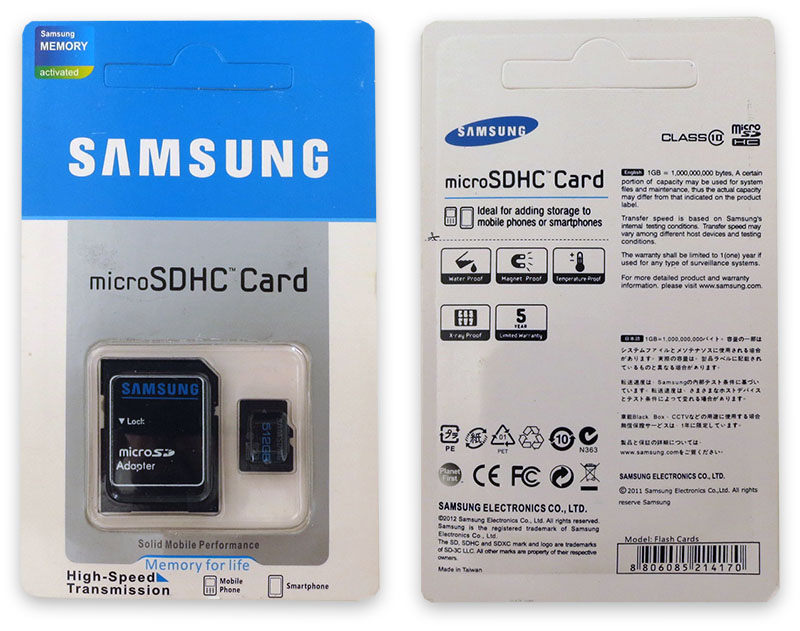
Counterfeit Criteria:
Non-existent 512GB card. Samsung does not have such capacity in Micro SD format.
"Model: Flash Cards." What the hell is this?
Invalid UPC barcode 8806085214170

Fake Criteria:
Card capacity not indicated on package.
The usual "SDHC" instead of "SDXC".
There are a lot of inaccuracies on the back. For example, why do I need a 2GB-32GB card label if I have 64GB in theory? No model number. UPC 8806071456836 barcode from 4GB card.
Total
As I wrote above, all these cards are actually 8GB Micro SDHC Class 2 cards.
All the cards above the back look like this:

All the cards on the back say:
MMB3R08BUACA-GE
Issue date code
Made in Taiwan
The numbers "08" in the first line indicate the capacity of 8GB.
MMB3R08BUACA-GE is a model of some Chinese manufacturer whose cards are used for fakes. I could not find which one. I have similar models on old noname cards of small sizes.
What to do?
If the seller sent a card, which during the check turned out to be much less capacity, then you need to demand a refund.
It happens that the seller might not know (just bought a batch and now sells at retail), so I advise you to demand a refund politely enough. Roughness will not accelerate the process.
The main thing is not to hesitate.
If the seller does not respond, then you can safely open a dispute on the discrepancy with the description.
I also noticed that almost all branded cards on Ali are fake. There are real ones on eBay, but you need to look and carefully study the photos (if real) and ask the seller to provide them if there are no photos.
It is especially worth paying attention to the back side of the card (if possible), so that there would not be “MMB3R08BUACA-GE” or something very close to this. I met variations MMB3R08GUACA-GE, MMB3D08BUACA-GE, MMB3D08GUACA-GE, MMB3R08GUACA-GE.
There are fakes everywhere. For example, on Amazon I have seen quite a few explicit fakes. After all, not only Amazon sells products on Amazon.
If you need a 100% guarantee, then you need to buy more expensive from authorized sellers. You just need to find out from the manufacturer exactly who is authorized, as some sellers may write that they are authorized, but in fact they are not.
If you take the cards from the photograph at the beginning of this article and turn them around, you get the following picture:

Who will guess which one is Sandisk, Samsung, AData? The correct answer is none.
Tips
In the comments, they asked about tips for searching. Add to the article here.
- Search for a UPC barcode
I just paste this code into Google and see what I find. Usually I find a product that is attached to them.
There are sites for searching by UPC barcode. For example, www.upcindex.com , but I don’t know how complete one site can be, so I’m just looking through a search engine. - Search for a model
The manufacturer’s website indicates its models on its website. You can also search through a search engine. If the models will be located anywhere, but not at the manufacturer, then this is suspicious.
Sandisk example: Usually their models look something like this: "SDSDQUA-032G-A46A." That is, the “032G” part means 32GB.
If the package instead has “0000”, which means “SDSDQUA-0000-A46A”, then this is a fake.
Or it happens that they simply remove this part and get “SDSDQUA-A46A”. Again, a non-existent model is obtained.
For example, if you go to the Sandisk website and open a Micro SD card for Android , then in the “Specifications” tab there will be all models of this series for different regions. - Back of the card
These cards have different designations on the back.
For example, Sandisk simply writes a serial number. For example, “12038179381731. Made in China. " This inscription is rotated 90 degrees.
Sony also has a serial number at the back and is also rotated 90 degrees.
For example, the inscription on the back of the original Sandisk card looks like this:
Funny moments
Sometimes I like to watch sellers otmazyvayut about this.
Here are some of these excuses:
" This card has been upgraded from 8GB to 128GB ." What nonsense? Micro SD card can’t just be upgraded. This is not a computer where you can simply replace the memory module.
" Windows shows 64GB, so it's 64GB ." It is clear that Windows just shows what the card itself has told. Windows does not check.
" To reduce the price, this card is designated as SDHC instead of SDXC ." This does not affect the price if it were an original card.
Regarding typos on the packaging: “Sandisk just got it wrong, but the card is still 256GB.” Oh well.
"This is a real card because I bought it from trusted sources . "Has anyone seen these sources? It's Uncle Shau Lau! He couldn’t deceive.
" I work in the secret department of Samsung, so I have 512GB cards. They gave them to us and allowed to sell . ”Three times“ ha. ”This seller knows for sure that he sells fakes.
